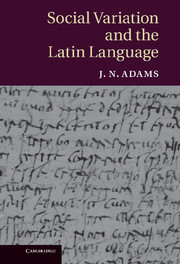Description
Social Variation and the Latin Language
Author: Adams J. N.
A major history of many of the developments undergone by the Latin language as it changed into Romance languages.
Language: English
Subject for Social Variation and the Latin Language:
Approximative price 147.50 €
In Print (Delivery period: 14 days).
Add to cart
Social Variation and the Latin Language
Publication date: 05-2013
Support: Print on demand
Publication date: 05-2013
Support: Print on demand
Approximative price 36.76 €
In Print (Delivery period: 14 days).
Add to cart
Social Variation and the Latin Language
Publication date: 09-2016
Support: Print on demand
Publication date: 09-2016
Support: Print on demand
Description
/li>Contents
/li>Biography
/li>
Languages show variations according to the social class of speakers and Latin was no exception, as readers of Petronius are aware. The Romance languages have traditionally been regarded as developing out of a 'language of the common people' (Vulgar Latin), but studies of modern languages demonstrate that linguistic change does not merely come, in the social sense, 'from below'. There is change from above, as prestige usages work their way down the social scale, and change may also occur across the social classes. This book is a history of many of the developments undergone by the Latin language as it changed into Romance, demonstrating the varying social levels at which change was initiated. About thirty topics are dealt with, many of them more systematically than ever before. Discussions often start in the early Republic with Plautus, and the book is as much about the literary language as about informal varieties.
Preface; Part I. Introduction: 1. Introduction: 'Vulgar Latin' and social variation; Part II. Phonology and Orthography: 2. Phonology: introductory remarks; 3. Vowel system; 4. Diphthongs; 5. Syncope; 6. Hiatus; 7. The aspirate; 8. Final consonants; 9. Contact assimilation; 10. B/V; 11. Phonology: conclusions; Part III. Case and Prepositions: 12. The nominative and accusative; 13. Oblique cases and prepositional expressions; 14. Miscellaneous uses of the accusative; 15. Locative, directional and separative expressions: some variations and conflations; 16. The reflexive dative; 17. Prepositions and comparative expressions; 18. Case and prepositions: some conclusions; Part IV. Aspects of Nominal, Pronominal and Adverbial Morphology and Syntax: 19. Gender; 20. Demonstrative pronouns: some morphological variations; 21. The definite article and demonstrative pronouns; 22. Suffixation (mainly adjectival) and non-standard Latin; 23. Compound adverbs and prepositions; Part V. Aspects of Verbal Morphology and Syntax: 24. Past participle + habeo; 25. The periphrastic future and conditional, and present for future; 26. Reflexive constructions and the passive; 27. The ablative of the gerund and the present participle; Part VI. Aspects of Subordination: 28. Reported speech; 29. Indirect questions; Part VII. Aspects of the Lexicon and Word Order: 30. The lexicon, a case study: anatomical terms; 31. The lexicon: suppletion and the verb 'go'; 32. Word order, a case study: infinitive position with auxiliary verbs; Part VIII. Summing Up: 33. Final conclusions.
J. N. Adams is an Emeritus Fellow of All Souls College, Oxford and a Fellow of the British Academy. He was previously a Professor of Latin at the Universities of Manchester and Reading. He is the author of many books on the Latin language, including most recently The Regional Diversification of Latin, 200 BC–AD 600 (Cambridge, 2007) and Bilingualism and the Latin Language (Cambridge, 2003).
© 2024 LAVOISIER S.A.S.



